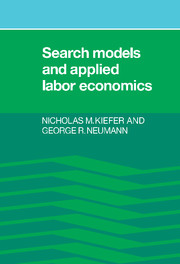Book contents
- Frontmatter
- Contents
- Preface
- 1 Introduction
- Part I Wages, reservation wages, and duration
- Part II Continuous-time models of duration
- Part III Applications
- 8 Structural and reduced form approaches to analyzing unemployment durations
- 9 Wages and the structure of unemployment rates
- 10 How long is a spell of unemployment? Illusions and biases in the use of CPS data
- Part IV Mobility and contracting
- Index
8 - Structural and reduced form approaches to analyzing unemployment durations
Published online by Cambridge University Press: 06 October 2009
- Frontmatter
- Contents
- Preface
- 1 Introduction
- Part I Wages, reservation wages, and duration
- Part II Continuous-time models of duration
- Part III Applications
- 8 Structural and reduced form approaches to analyzing unemployment durations
- 9 Wages and the structure of unemployment rates
- 10 How long is a spell of unemployment? Illusions and biases in the use of CPS data
- Part IV Mobility and contracting
- Index
Summary
Introduction
Workers with low current earnings comprise two types of individuals: those whose personal characteristics lead to their being permanently in the low-wage state, and those who are, owing to some exogenous event, only transitorily in the low-wage state. This distinction is recognized implicitly in public policies designed to aid such workers. Workers who are viewed as “permanent” low wage earners are provided programs which attempt to alter their personal characteristics – e.g., manpower training programs. For those workers viewed as only transitorily in the low earning state, services provided tend to be short-term income maintenance, e.g., unemployment insurance following losses in jobs and Workmen's Compensation following debilitating work injuries. The distinction between permanent and transitory is not rigid, however, since not all workers recover from a transitory shock such as the loss of a high-wage job. Similarly, some workers with characteristics normally associated with permanent low wage earnings esape to the high-wage sector. The size of the pool of low wage at any time depends then upon the magnitudes of these inflows and outflows. Although economists cannot claim to understand fully how public programs affect all movements between the two states, a clearer picture is emerging on the effects of manpower training programs and the movement out of the low-earnings state.
- Type
- Chapter
- Information
- Search Models and Applied Labor Economics , pp. 163 - 178Publisher: Cambridge University PressPrint publication year: 1989



